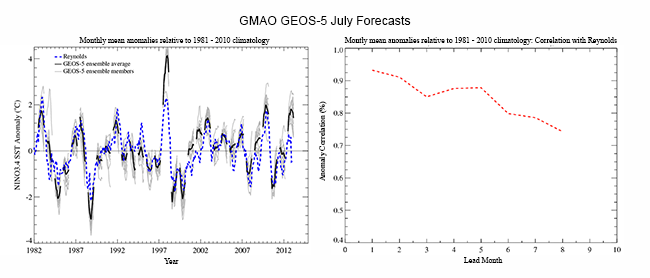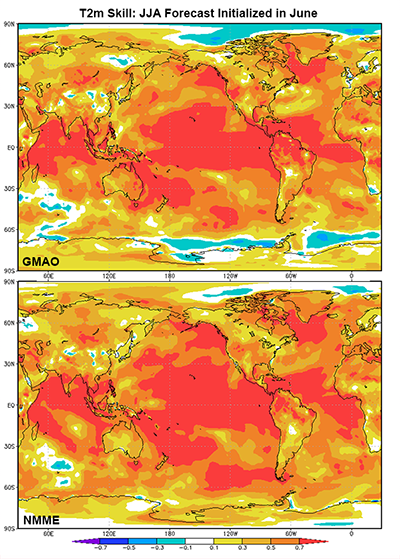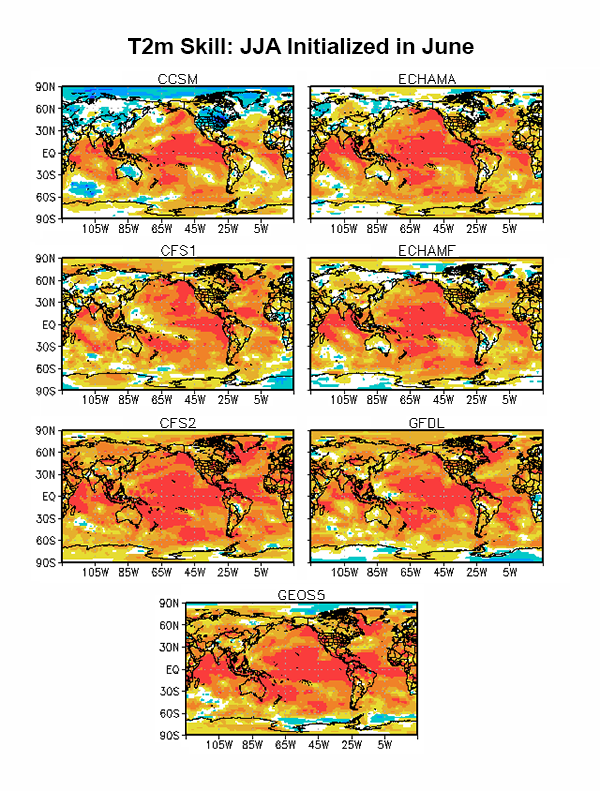GEOS-5 contributions to the National Multi-Model Ensemble
March 2013
Advances in computing and in climate modeling have greatly improved the quality of climate simulations over the last few decades, but forecasting climate variability still remains a challenge. Climate variability is irregular by nature, and the models used to forecast climate still contain substantial errors, including bias. As part of an on-going effort to address these problems, the GMAO is taking part in the National Multi-Model Ensemble project (NMME), a collaborative multi-agency effort that includes NASA, NOAA, the NSF, and the DOE. The goals of this effort are to capitalize on the modeling investments within the U.S. and elsewhere to produce routine real-time multi-model ensemble intra-seasonal-to-interannual (ISI) predictions, and to provide them to the NOAA Climate Prediction Center (CPC) on an experimental basis for evaluation and consolidation as a multi-model ensemble prediction system. GMAO benefits from this collaboration in a number of ways, including a near-real-time and on-going evaluation of our GEOS-5 prediction system by numerous users with a wide range of potential applications.
The NMME, which is ultimately expected to have 100 ensemble members, is currently comprised of about 90 ensemble members from seven different forecast models. The effort aims not only to improve ISI prediction, but also to quantify forecast uncertainty better. Multi-model ensemble forecasting is used because multi-model forecasts generally have higher skill than any single model (e.g., Krishnamurti et al., 2000; Palmer et al., 2004), and because the use of multiple, independent models makes quantifying forecast uncertainty easier. A high level of agreement (narrow spread) of forecasts from different models should inspire more confidence in forecasts than a wide spread, although the extent to which the spread of current ensembles is a good indicator of forecast skill on these time scales still remains an open question.
Each month, the GMAO contributes 11-member global, near-real-time ensemble of GEOS-5 forecasts to the NMME forecast effort. The GEOS-5 ensemble is comprised of a mix of lagged forecasts (initialized every five days) and simultaneous forecasts (six forecasts initialized on whichever of the five-day starts is closest to the first of the month). The simultaneous ensembles are generated from breeding (e.g., Yang et al., 2008; Ham et al., 2012a) and other simpler perturbation approaches. The forecast duration is 9 months. The initial conditions for the ocean and sea-ice are generated using the GEOS ODAS 5.0 and 5.1 (see Vernieres et al., 2012). The latter system is used when satellite altimetry have been assimilated. The atmospheric initial conditions are derived from MERRA.
Certain fields from all forecasts must be made available to the CPC by the eighth day of each month so that the forecasts may be used for operational guidance. In addition to the real-time forecasts, each system also provides the NMME with 30 years of hindcasts, from 1981 to 2010, which are used to evaluate the forecast systems and calibrate the real-time forecasts by, for example, correcting for the climatological forecast drift.
Although the NMME has been producing real-time forecasts and providing them to the CPC on a monthly basis since August of 2011, much of the work proposed by the NMME involves analyzing the 30 years of hindcasts (from 1981 to 2010). This part of the NMME project, termed "Phase II," seeks to evaluate, design, and test a near-operational multi-model ensemble forecast system. Key issues to be explored involve the optimal number of ensemble members to maximize skill and minimize computational cost, whether and how model forecasts should be weighted, forecast sensitivities to initial conditions, and how forecasts perform at multiple time scales, with a special interest on time scales longer than 14 days, but less than a season.
In addition to investigating how to create the optimum multi-model ensemble forecast, the NMME and the GMAO seek to evaluate ensemble forecast performance in some select areas. Of particular interest is the NMME's ability to monitor and predict drought. The GMAO and several other NMME member organizations already take part in drought monitoring and prediction, and the GMAO conducts research on drought and the driving forces behind it.
The NMME seeks to evaluate the skill at forecasting phenomena, like the Madden-Julian Oscillation (MJO), that occur on sub-seasonal time scales. On these time scales, different approaches to ensemble generation, including breeding, might be needed (e.g., Ham et al., 2012b).
Analyses of NMME hindcasts have shown that the NMME is capable of forecasting sea surface temperature (SST) and two meter temperature (T2m) rather well. Anomaly correlations for hindcasts from 1982 to 2010 of SSTs (available at cpc.ncep.noaa.gov/products/NMME) are above 60% over much of the ocean for lead times of up to three months, and are above 70% for a large portion of the equatorial Pacific, a region especially important for forecasting the El Niño - Southern Oscillation (ENSO). Skill stays high in certain ocean regions, like the eastern equatorial Pacific, for lead times of up to five months. GEOS-5's success in forecasting SST variability in the equatorial Pacific is evident from an inspection of the Niño-3.4 SST hindcasts (see Figures 1 and 2).

click for larger image

click for larger image
Anomaly correlations for NMME hindcasts for T2m also have substantial skill over much of the globe. As can be seen in Figures 3 and 4, GEOS-5 contributes to the high skill of the ensemble in certain geographic areas, like the North and South American landmasses, and the Indian Ocean. As expected, the anomaly correlations for precipitation in hindcasts (not shown) are not as high as those for SST and T2m. However, the ensemble has been found to be more skillful at forecasting precipitation than any of the individual NMME models.

click for larger image

click for larger image
Preliminary analyses of NMME real-time forecasts have shown the potential of the NMME forecasts for operational purposes (see Becker et al., 2012). All NMME member hindcasts and forecasts are openly available for research purposes at iridl.ldeo.columbia.edu/SOURCES/.Models/.NMME.
Related Links
References
Becker, E., Q. Zhang, H. van den Dool, S. Saha, P. Peng, M. Peña, P. Tripp, J. Huang, 2012: Evaluation of the National Multi-Model Ensemble System for seasonal and monthly prediction. 36th NOAA Annual Climate Diagnostics and Prediction Workshop: Science and Technology Infusion Climate Bulletin. Fort Collins, CO, NOAA's National Weather Service.
Ham, Y.-G., M. Rienecker, S. Schubert, J. Marshak, S.-W. Yeh, and S.-C. Yang, 2012a: The decadal modulation of coupled bred vectors. Geophys. Res. Lett., 39, L20712. doi:10.1029/2012GL053719.
Ham, Y.-G., S. Schubert, Y. Chang, 2012b: Optimal initial perturbations for ensemble prediction of the Madden-Julian Oscillation during boreal winter. J. Climate, 25, 4932-4945. doi:10.1175/JCLI-D-11-00344.1.
Krishnamurti, T. N., C. M. Kishtawal, Z. Zhang, T. LaRow, D. Bachiochi, E. Williford, S. Gadgil, S. Surendran, 2000: Multimodel ensemble forecasts for weather and seasonal climate. J. Climate, 13, 4196.4216. doi:10.1175/1520-0442(2000)013<4196:MEFFWA>2.0.CO;2.
Palmer, T. N., and Coauthors, 2004: Development of a European multimodel ensemble for seasonal-to-interannual prediction (DEMETER). Bull. Amer. Meteor. Soc., 85, 853.872. doi:10.1175/BAMS-85-6-853.
Yang, S. C., E. Kalnay, M. Cai, and M. Rienecker, 2008. Bred vectors and forecast errors in the NASA coupled general circulation model. Mon. Wea. Rev., 134, 1305-1326. doi:10.1175/2007MWR2118.1.
Contributors: Siegfried Schubert, Zhao Li, Jelena Marshak
« Climate Diagnostics and Prediction
« GMAO Research Highlights

